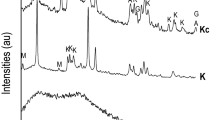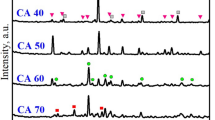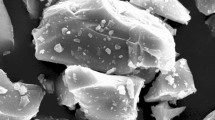Abstract
THE CaSO4.½H2O – H2O system has long been investigated as a simple system of cementitious material1,2. Though the net volume of a CaSO4.½H2O – H2O paste decreases by 7 per cent, the gross volume increases by about 0.5 per cent during hardening. There is no satisfactory theory to explain this anomaly. During an examination of the hydration of Portland cements3, it was seen that gypsum at first precipitates as very fine needles and at a later stage some of these needles have grown while others have disappeared. It was thought that this might also occur during the hydration of CaSO4.½H2O. To check this hypothesis two batches of CaSO4.½H2O were made by heating gypsum (analytical reagent quality, B.D.H.) at 120° C. One batch was heated to constant weight, the other much longer, and both were cooled over fused calcium chloride in a desiccator. The batch heated for a long time proved to be slower in reaching a given hydration stage, but the course of the reaction was otherwise the same. These CaSO4.½H2O batches were then ground to pass a 200 mesh Brit. Stand. sieve. Six pastes were made, using three different water/solid ratios. In all cases more than sufficient water was present for complete hydration. 24 specimens from these pastes were examined electron-optically using techniques described previously4. Figs. 1–3 show different stages of hydration of CaSO4.½H2O. At first very fine crystals of gypsum were formed (Fig. 1). The amount of these very fine gypsum crystals formed and the length of time they lasted depended on the water/solid ratio and the reactivity of the solid. Fig. 2 represents the stage of hydration of CaSO4.½H2O paste at the beginning of set. By this time the crystals had become longer and in most cases much thicker, although a significant number of very thin crystals were present. A considerable amount of CaSO4.½H2O was left unreacted at this stage. Fig. 3 represents the structure of completely set paste. At this stage the paste is a mixture of large and very small crystals. Most of the CaSO4.½H2O has been hydrated by this time.
This is a preview of subscription content, access via your institution
Access options
Subscribe to this journal
Receive 51 print issues and online access
$199.00 per year
only $3.90 per issue
Buy this article
- Purchase on Springer Link
- Instant access to full article PDF
Prices may be subject to local taxes which are calculated during checkout
Similar content being viewed by others
References
Lea, F. M., The Chemistry of Cement and Concrete, 215 (Arnold, London, 1956).
Jørgensen, K. D., Silicate Ind., No. 11, 1 (1961).
Chatterji, S., and Jeffery, J. W., J. Amer. Ceram. Soc., 46, No. 6, 268 (1963).
Chatterji, S., and Jeffery, J. W., J. Amer. Ceram. Soc., 45, No. 11, 536 (1962).
Lea, F. M., and Nurse, R. W., Disc. Faraday Soc., No. 5, 350 (1949).
Author information
Authors and Affiliations
Rights and permissions
About this article
Cite this article
CHATTERJI, S., JEFFERY, J. Crystal Growth during the Hydration of CaSO4.½H2O. Nature 200, 463–464 (1963). https://doi.org/10.1038/200463a0
Issue Date:
DOI: https://doi.org/10.1038/200463a0
This article is cited by
-
Salt Weathering in Deserts
Nature (1968)
Comments
By submitting a comment you agree to abide by our Terms and Community Guidelines. If you find something abusive or that does not comply with our terms or guidelines please flag it as inappropriate.



